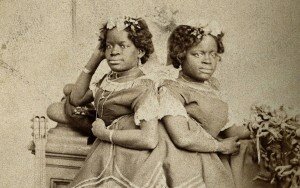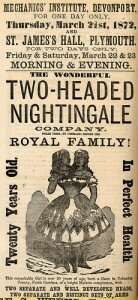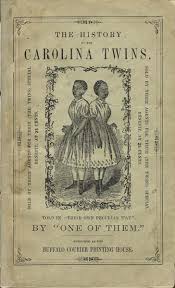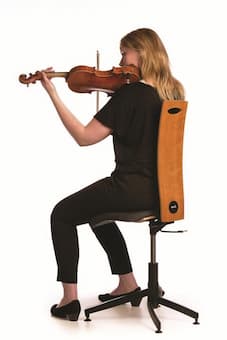 When the singing sensation Jenny Lind disembarked from the steamship “Atlantic” to begin her American tour on 1 September 1850, roughly 30,000 onlookers had gathered around the waterfront to catch a glimpse of the Swedish opera star. Her American promoter P.T. Barnum had dubbed her the “Swedish Nightingale,” and the nine-month engagement was a huge commercial success netting a whopping 21 million dollars in the modern equivalent. Inspired by Lind’s success, theatres and variety shows across the country advertised nightingales of various nationalities, but none as remarkable as Millie and Christine McCoy.
When the singing sensation Jenny Lind disembarked from the steamship “Atlantic” to begin her American tour on 1 September 1850, roughly 30,000 onlookers had gathered around the waterfront to catch a glimpse of the Swedish opera star. Her American promoter P.T. Barnum had dubbed her the “Swedish Nightingale,” and the nine-month engagement was a huge commercial success netting a whopping 21 million dollars in the modern equivalent. Inspired by Lind’s success, theatres and variety shows across the country advertised nightingales of various nationalities, but none as remarkable as Millie and Christine McCoy.
 Advertised as “The Eighth Wonder of the World,” “The Carolina Twins,” and “The Two-Headed Nightingale,” the sisters were conjoined twins who even performed at Buckingham Palace for Queen Victoria in 1871. Joined at the lower spine, “the twins stood at an angle away from each other. Each sister had her own arms and limbs, although they shared a pelvis.” Born into slavery, they were sold at the age of 10 months under an agreement that paid a percentage of their exhibition fee to their parents.
Advertised as “The Eighth Wonder of the World,” “The Carolina Twins,” and “The Two-Headed Nightingale,” the sisters were conjoined twins who even performed at Buckingham Palace for Queen Victoria in 1871. Joined at the lower spine, “the twins stood at an angle away from each other. Each sister had her own arms and limbs, although they shared a pelvis.” Born into slavery, they were sold at the age of 10 months under an agreement that paid a percentage of their exhibition fee to their parents.
Johannes Brahms: 4 Duets, Op. 61
 They publically appeared in circuses and roadshows as “sideshow freaks and human oddities,” and commanded an additional entrance fee just to be seen. At the age of three they first appeared at P.T. Barnum’s American Museum in New York City, and an envious showman kidnapped the twins and shipped them to England. The girls were eventually returned from overseas, and learned to read and write—including French and German—and became accomplished pianists, singers, and dancers. They continued to work in the circus scene for the next 30 years. However, they were no longer sideshow attractions, but a singing duo rebranded as “The Two-Headed Nightingale,” with Christine singing soprano, and Millie alto. Drawing huge crowds with their performances, the twins earned roughly 600 dollars a week, a near fortune at the time. They bought and retired to their ancestral farm in Columbus County in North Carolina, and published an autobiography in 1869. Millie and Christine continued to be active in “charity work for Black schools and churches in the American South,” and died from tuberculosis on 8 October 1912.
They publically appeared in circuses and roadshows as “sideshow freaks and human oddities,” and commanded an additional entrance fee just to be seen. At the age of three they first appeared at P.T. Barnum’s American Museum in New York City, and an envious showman kidnapped the twins and shipped them to England. The girls were eventually returned from overseas, and learned to read and write—including French and German—and became accomplished pianists, singers, and dancers. They continued to work in the circus scene for the next 30 years. However, they were no longer sideshow attractions, but a singing duo rebranded as “The Two-Headed Nightingale,” with Christine singing soprano, and Millie alto. Drawing huge crowds with their performances, the twins earned roughly 600 dollars a week, a near fortune at the time. They bought and retired to their ancestral farm in Columbus County in North Carolina, and published an autobiography in 1869. Millie and Christine continued to be active in “charity work for Black schools and churches in the American South,” and died from tuberculosis on 8 October 1912.
More Behind the Scenes
-
 The Goldilocks Principle in the Performance of Music “Allow everything to move that needs to move”
The Goldilocks Principle in the Performance of Music “Allow everything to move that needs to move” -
 BodyMinded Thinking for the Fingers and Thumbs Learn about the ease of movement, control and power of your fingers
BodyMinded Thinking for the Fingers and Thumbs Learn about the ease of movement, control and power of your fingers -
 BodyMinded Thinking for Dynamic Postural Support What should musicians be aware of as they are standing/sitting?
BodyMinded Thinking for Dynamic Postural Support What should musicians be aware of as they are standing/sitting? - The Sorcerer’s Apprentice
Leschetizky Legacy “People forget the artists who have only played, but pupils carry on the teacher’s memory.”



